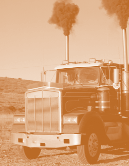[sharelines]Climate policy moves to address transportation, which contributes one-third of CO2 emissions in the US.
Climate change is creeping into the public consciousness. Arcane scientific debates are front page news. Best-selling authors and Hollywood movies feature climate change. Presidents and Prime Ministers are becoming conversant in climate change science and policy. It is time for the transport sector to become part of the solution. Opportunities to reduce climate impacts abound in transportation, with broad economic, environmental, and social benefits. We need new partnerships among industry, political leaders, and the public, and a new culture of innovation that builds synergies across technological and behavioral initiatives.
Climate policy first became front page news in the late 1980s, when several years of record high temperatures focused attention on what had been a remote scientific phenomenon. Its profile was further raised by the 1992 Earth Summit in Rio de Janeiro, Brazil, when delegates from 189 countries endorsed voluntary reductions in emissions of heat-trapping greenhouse gases (GHG). At the follow- up 1997 meeting in Kyoto, delegates voted to replace voluntary reductions with mandatory emission- reduction targets for industrialized nations. This Kyoto Protocol formally went into effect in February 2005 after countries contributing 55 percent of all GHG emissions had finally approved it (with Russia’s approval pushing it over the required threshold). Every industrialized country in the world adopted the Protocol except the United States and Australia.
The Kyoto Protocol suffers from many weaknesses. It imposes no penalties for non- compliance, excludes large developing countries such as China and India, and provides many opportunities to buy compliance without any real effort to reduce emissions. Russia, for instance, with a drop in energy use from the collapse of its economy since 1990, is allowed under the Protocol to sell unearned credits to other countries. But the Protocol has focused attention on climate change and is scheduled to be replaced with a new international agreement in 2012.
Meanwhile, worldwide political commitment to GHG reduction is clearly growing, even in the US. More and more cities, states, and companies are embracing strategies to reduce GHGs. But political commitments are not yet translating into action. Emissions continue to grow, not only from the US and developing countries, but also from most Kyoto signatories.
Changing the Climate
While political wheels spin, greenhouse gas emissions—mostly carbon dioxide from burning fossil fuels—continue to increase. Official US government sources estimate that global CO2 emissions increased from 21.4 billion metric tons in 1990 to roughly 6 billion tons in 2004, and expect them to increase another fifty percent by 2025, an increase of two percent per year.
Mounting emissions are contemporaneous with mounting scientific evidence that GHG emissions are likely causing significant shifts in the Earth’s climate. The eight hottest years in more than a century of record-keeping occurred in the last decade. Analyses at the Center for Atmospheric Research in Colorado concluded that 75 percent of the four million square miles of permafrost in Arctic regions could melt in the next hundred years, and a multinational assessment predicted an almost complete melting of the Arctic ice cap (during the summer) by the end of this century.
 The Third Assessment Report of the Intergovernmental Panel on Climate Change, representing the consensus of 1,500 scientists, concludes that the Earth’s climate has demonstrably changed on both global and regional scales since the beginning of the industrial revolution, and that new and strong evidence indicates that most of the warm- ing observed over the last fifty years is attributable to human activities. Scenarios based on a range of climate models point to an increase in global average surface temperature of 1.4° to 5.8°C over the period 1990 to 2100.
The Third Assessment Report of the Intergovernmental Panel on Climate Change, representing the consensus of 1,500 scientists, concludes that the Earth’s climate has demonstrably changed on both global and regional scales since the beginning of the industrial revolution, and that new and strong evidence indicates that most of the warm- ing observed over the last fifty years is attributable to human activities. Scenarios based on a range of climate models point to an increase in global average surface temperature of 1.4° to 5.8°C over the period 1990 to 2100.
Despite mounting scientific evidence of global warming, changing climates, and melting polar ice, the exact scientific connections between increased GHG emissions and climate change remain murky. It is not clear how much, how fast, and where the climate will change, nor what the effect of that change will be on land use, biodiversity, agriculture, and fresh water supplies, to mention only a few areas of concern.
What is clear is that global emissions of GHGs are on a steep upward trajectory. Before industrialization and the widespread use of fossil fuels, the concentration of CO2 in the atmosphere was 275 parts per million (ppm). It is now 375 ppm. Climate scientists believe that doubling CO2 to 550 ppm threatens radical shifts in precipitation, temperature, and water currents. To stabilize concentrations, even at 550 ppm, would require a sharp reduction in emissions across all economic sectors—by about one third of forecasted levels for 2050 and over two thirds for 2100. Stabilizing concentrations at lower levels would require even more dramatic reductions.
There is no doubt that large rapid increases in GHG emissions have the potential to alter the climate in ways that would be catastrophic for human civilization and the Earth’s ecology. And there is no doubt that the US is by far the world’s leading GHG and CO2 emitter, accounting for about 27 percent of the global total. China is projected to eclipse the US around 2020 in total emissions, but the US will remain far ahead in emissions per capita into the foreseeable future.
Driving Emissions Up
Transportation is the fastest growing source of GHG emissions in the world. Vehicle usage continues to increase, rapidly in some regions. Within the US, transportation accounts for one third of all emissions, growing at about 1.5 percent per year. Most transportation CO2 emissions come from cars and trucks burning petroleum fuels: sixty percent from gasoline combustion in cars, 22 percent from diesel trucks and buses, and the rest from rail, off-road vehicles, aviation, and marine transportation.
Within the US, transportation accounts for one third of all emissions, growing at about 1.5 percent per year.
It is even worse than it seems. That is because, as conventional oil supplies become scarcer, the oil industry is turning to unconventional carbon-intensive oil sources such as tar sands and heavy oil. Manufacturing gasoline from tar sands produces about fifty percent more CO2 emissions than making gasoline from conventional oil. Even if global oil consumption were capped, using more carbon-intensive oil sources means more GHG emissions. Amazingly, we are re-carbonizing our fuel system when virtually everyone accepts that we should be doing just the opposite.
The challenge is huge.
The Asilomar Declaration
Alarmed by simplistic public discourse and the enormity of the climate challenge, a group of individuals organized a high-level meeting focused on transportation energy policy and investments. Two hundred leaders and experts from automotive and energy industries, start-up technology companies, governments from around the world, public interest groups, academia, and national energy laboratories assembled for three days in August 2005 at the 10th Biennial Conference on Transportation and Energy Policy at California’s Asilomar Conference Center. They asked what could or should be done to reduce emissions from the transport sector. Three broad strategies for reducing greenhouse gas emissions were investigated: reducing motorized travel, shifting to less energy-intensive modes, and changing fuel and propulsion technologies.
Conference discussions revolved around four key questions. What is the role of technology versus behavioral changes? Are entirely new technologies required?
What is the role of transportation? Which policy instruments might be most effective, and which most acceptable? The group never arrived at definitive answers, but several threads of agreement surfaced. These were put into writing and endorsed as the Asilomar Declaration.
DECLARATION 1: It is the consensus of the 10th Biennial Conference on Transportation and Energy Policy that climate change is real. Transportation-related GHG emissions are a major part of this global problem, and they must be reduced.
This rather bald assertion states as clearly as possible what is a broad consensus. It is important for bodies of informed and influential individuals to make simple, definitive statements.
DECLARATION 2: US national policy has so far failed to adequately address the role of transportation in climate change. This must be remedied.
International and local initiatives are expanding and will eventually force a coherent national policy to emerge within the United States and other nations. California is a leader. In June 2005, Governor Schwarzenegger signed an executive order calling for an eighty percent reduction in GHG emissions by 2050 (with intermediate goals by 2010 and 2020). Many cities and states are adopting their own goals and in some cases firm policies and rules. The public is beginning to demand governmental and corporate responsibility in this area. Many governments and companies are responding with their own roadmaps.
These are just baby steps, though, especially in the transportation sector. One assertive action is in California, which passed a law in 2002 to reduce GHG emissions from vehicles by about thirty percent by 2016. Other states have followed suit and adopted the same rules. Though the law is blessed with bipartisan support, the auto industry is challenging its legality, asserting that it is in effect a fuel economy standard and therefore falls under the authority of the federal government. The case will likely not be settled until at least 2007. California also just passed legislation calling for a 25 percent reduction in CO2 emissions from all sources by 2020 and creating a process to enact rules to achieve that reduction.
 The motivation for the California laws was inaction in Washington, DC. Inaction in climate policy was, and is, due to a variety of factors. It is explained in part by the nation’s culture of individualism and consumer sovereignty, its historical abundance of energy resources, and relative isolation from international conflict. It is also due to the powerful interests of the fossil fuel industries and the financial woes of the Detroit automakers and many of their suppliers. Labor unions and the many states housing auto factories fear that GHG rules will bankrupt many companies and cause great harm to local economies. While this fear is dissipating as the far healthier Japanese and European car companies populate the country with new factories, it remains a powerful concern. National policy makers continue to resist a national climate-change strategy, including a strategy for transportation. National debates on transportation CO2 are characterized largely by resistance to increases in fuel economy standards. The only progress nationally in the US at this time is a minor increase in fuel economy standards for light-duty trucks.
The motivation for the California laws was inaction in Washington, DC. Inaction in climate policy was, and is, due to a variety of factors. It is explained in part by the nation’s culture of individualism and consumer sovereignty, its historical abundance of energy resources, and relative isolation from international conflict. It is also due to the powerful interests of the fossil fuel industries and the financial woes of the Detroit automakers and many of their suppliers. Labor unions and the many states housing auto factories fear that GHG rules will bankrupt many companies and cause great harm to local economies. While this fear is dissipating as the far healthier Japanese and European car companies populate the country with new factories, it remains a powerful concern. National policy makers continue to resist a national climate-change strategy, including a strategy for transportation. National debates on transportation CO2 are characterized largely by resistance to increases in fuel economy standards. The only progress nationally in the US at this time is a minor increase in fuel economy standards for light-duty trucks.
But the challenge for the transport sector extends far beyond national fuel economy rules. A broader range of mitigation strategies is necessary, since emissions are linked to the entire range of traveler behaviors and land use decisions. And they must include adaptation strategies, since changes in climate threaten transportation infrastructure. Thus, the climate debate must address individual responsibility and government initiatives to manage land use, moderate vehicle use, and protect the integrity of the transport infrastructure.
Inaction on climate policy is also explained by the remoteness of the effects of global warming. Fortunately, solutions to climate change overlap with more politically salient challenges such as energy security, local air pollution, and traffic congestion. Intensifying tensions over these issues are likely to motivate innovation and policy action well before global warming does. In any case, Asilomar participants agreed that actions to reduce GHG emissions and oil use must accelerate.
Opportunities abound to reduce transportation-related GHG emissions. Many actions cost little and have quick paybacks, yet trends are towards creating higher emissions.
DECLARATION 3: By judiciously crafting a portfolio of solutions, it is possible to reduce transportation-related GHG emissions while creating an efficient and effective transportation system for current and future generations.
Opportunities abound to reduce transportation-related GHG emissions. These include improved fuel efficiency, improved fuel and vehicle technologies, a more robust mix of transportation fuels, and changes in travel behavior that improve the efficiency of the transportation system. Many actions cost little and have quick paybacks, yet little progress is being made. All trends are towards creating higher emissions. Homes and jobs continue to disperse, causing people to travel ever longer distances; vehicles are becoming larger and more powerful; petroleum fuels continue to dominate; unconventional, carbon- intense petroleum sources are replacing conventional petroleum; and transit is stuck at two percent of passenger travel in the US. Because the rate of change in the transport sector is so slow—in terms of land use, vehicle turnover, and fuels infrastructure—even under the most ambitious scenarios, it will be a long time before the upward trajectory of GHG emissions is bent downward. New transportation fuels, new fuel technologies, new user behaviors, and new institutions are needed, and they are not happening.
Because the rate of change in the transport sector is so slow, it will be a long time before the upward trajectory of GHG emissions is bent downward.
Those few changes that are happening are negative or trivial. For example, ethanol made from corn is trumpeted as a clean fuel and received about $3 billion in corn and fuel subsidies in 2005, mostly from the federal government. General Motors touts ethanol in full-page color ads asserting that “yellow is green.” It is not. Corn ethanol provides no air quality benefit and little or no GHG benefit. Depending on circumstances and which assumptions and models one chooses to use, corn ethanol might increase or decrease GHGs compared to gasoline.
While lack of progress is discouraging, there are indeed many options for reducing fuel consumption and greenhouse gas emissions from vehicles. Over the last 25 years, vehicle fuel consumption rates have remained static—but not because technology is not improving. Today’s vehicles are far more energy efficient in a technical sense than vehicles of 25 years ago. What has happened is that the efficiency improvements—estimated at one to two percent per year—have been offset by increases in size and power. Twenty years ago, the average car accelerated from zero to sixty miles per hour in over fourteen seconds. Today’s cars need less than ten seconds. Today’s granny car would have qualified as a performance car 25 years ago. If performance and size had been frozen at 1981 levels, current vehicles would consume thirty percent less fuel.
With the advent of hybrid vehicle technology and improved diesel engines, and a storm of innovation in materials, electronics, and combustion, this one to two percent annual rate of improvement in efficiency should continue for many decades, resulting in large reductions in oil use and GHG emissions—but only if performance and size are capped.
 Even greater improvements are possible if low-carbon fuels and advanced technologies are introduced. Fuels can be made from cellulosic matter, including grasses, trees, and crop wastes such as wheat straw. These produce forty to ninety percent fewer emissions than gasoline, considering the full cycle of production, delivery, and combustion. If vehicles are powered by electricity from the grid, emissions could drop by up to seventy percent in many regions, especially in California where coal accounts for only about twenty percent of grid electricity (versus about sixty percent elsewhere in the US). And vehicles powered by hydrogen, even when the hydrogen is made from a fossil fuel such as natural gas (as it is in the US today), would significantly reduce emissions.
Even greater improvements are possible if low-carbon fuels and advanced technologies are introduced. Fuels can be made from cellulosic matter, including grasses, trees, and crop wastes such as wheat straw. These produce forty to ninety percent fewer emissions than gasoline, considering the full cycle of production, delivery, and combustion. If vehicles are powered by electricity from the grid, emissions could drop by up to seventy percent in many regions, especially in California where coal accounts for only about twenty percent of grid electricity (versus about sixty percent elsewhere in the US). And vehicles powered by hydrogen, even when the hydrogen is made from a fossil fuel such as natural gas (as it is in the US today), would significantly reduce emissions.
Some combination of these low-carbon and advanced options—electricity, biofuels, and hydrogen—will almost certainly replace petroleum eventually. But it will take considerable time, in part because it requires a transformation of the energy, agricultural, and automotive industries.
Human Factor
The other large set of solutions to increasing emissions is tied to shifts in travel behavior. With land use planning, tolls and other pricing schemes, investment in alternative travel modes, and improved system integration, energy-intensive travel could be reduced, along with air pollution, oil use, and greenhouse gas emissions.
The bad news is that these changes in travel behavior have proven even more challenging to bring about than changes in fuels and vehicles. The history of modern civilization is one of increasing mobility. Almost all forecasts anticipate escalating travel, even in the US, though an increasing share of it is by air (which is even more energy-intensive, but I leave that topic for others). How can the Earth sustain continuing increases in energy use? The first challenge is to create a more efficient transport system than today’s monoculture of two-ton vehicles serving all purposes in all places on all roads.
Imagine a seamless multi-layered transport system with high-speed bus and rail services fed by small neighborhood vehicles and shared cars. Imagine paratransit vehicles that detour from set routes to pick up and deliver passengers on a moment’s notice. Imagine greater use of telecommunications to make mode transfers seamless, and imagine more effective management of land to support these innovative services. Is this any more preposterous than transforming our energy, agricultural, and automotive industries?
Efforts to reduce, or at least restrain, travel are desirable for many reasons. Contrary to widely held beliefs in the transport community, it is not true that more vehicle travel is socially beneficial. Accessibility, yes; mobility, no. There are ways to increase accessibility without increasing mobility, as suggested above. Less vehicle travel not only reduces the threat of climate change and oil scarcity, but also reduces the total cost of transportation and can lead to more desirable and aesthetically pleasing communities. The reality, though, is that the potential for reducing energy use and GHGs through travel behavior changes is far more modest than through low-carbon and advanced technology strategies. Consider the impressive two-and-a-half-year effort by the Sacramento region to develop a transportation and land use plan to reduce travel and enhance the region’s quality of life, one of the most ambitious and engaged initiatives in the nation. Its most aggressive travel reduction scenario for 2050 produces only sixteen percent less travel per household. More reduction is plausible, but it would need a restructuring of the transportation system.
The historical resistance to change can and must be overcome. A new culture of innovation is needed in the transport sector.
The real lesson may be that more effort must be devoted to creating synergies among strategies. If land use were managed in such a way as to encourage the use of neighborhood vehicles, then the limited performance and size of those vehicles would facilitate the use of electric power (since large expensive batteries would not be needed). If electric power interfaces were created at transit stations to allow hybrid and fuel cell vehicles to serve as paid sources of peak power backup, then both transit and alternative fuel vehicles would receive a boost. And if a variety of local strategies were developed to encourage the use of low-carbon vehicles and fuels and innovative low-carbon mobility services (such as smart paratransit), then large reductions in greenhouse gases and fuel use would be possible. These synergistic opportunities are at hand, and their benefits are broad. The historical resistance to change can and must be overcome. A new culture of innovation is needed in the transport sector.
Innovation and Action
As this essay suggests, and as participants at the Asilomar conference quickly concluded, dramatic changes are needed in both technology and consumer behavior. Indeed, they go hand in hand. While it is true that entirely new technologies and new services are bother desirable and needed to meet the energy challenges of tomorrow, the reality is that behavioral changes in established industries and the consumer market must come first.
 As to the other questions posed to conference participants—the role of transportation vis-à-vis other sectors and the effectiveness and desirability of policy instruments—it was widely understood that these questions are second order. The more salient concern is the paucity of innovation and investment, and the lack of commitment. While some strategies may not be particularly efficient in meeting societal goals, such as ethanol from corn, the real point is that creating a culture of innovation and action must be the number one strategy.
As to the other questions posed to conference participants—the role of transportation vis-à-vis other sectors and the effectiveness and desirability of policy instruments—it was widely understood that these questions are second order. The more salient concern is the paucity of innovation and investment, and the lack of commitment. While some strategies may not be particularly efficient in meeting societal goals, such as ethanol from corn, the real point is that creating a culture of innovation and action must be the number one strategy.
In that light, the three Asilomar declarations are no radical. Conference participants simply agreed that global climate change is real, and that it is possible to reduce GHG emissions and still have an efficient and effective transportation system. One day soon the Asilomar Declarations will likely be regarded as startlingly timid. But at this time and place they represent an important statement. The challenge, enmeshed in the 3rd declaration, is how to proceed.
The key group, the responsible party, is the consumer of transportation services— us. The consumer lies at the intersection of three public and private groups—transportation, vehicle, and energy providers; infrastructure builders and managers; and land use planners and decision makers. Ultimately it is personal behavior—how we access transportation services and how we settle upon the land—that dictates the actions of infrastructure, energy, vehicle, and transportation providers. Since every individual is his or her own transportation planner and decision maker, the challenge of climate change can be addressed only by broad empowerment and participation.
The consumer lies at the intersection of three public and private groups—transportation, vehicle, and energy providers; infrastructure builders and managers; and land use planners and decision makers.
But researchers and policymakers have only a weak understanding of consumer behavior. It is increasingly clear that transportation has symbolic meaning to consumers beyond its utility—our travel behavior is clearly not explained by simplistic principles of economic rationality. Why did consumers binge on SUVs in the ’90s? Why are hybrids, despite their large cost premiums, appealing to so many consumers? We are still a long way from knowing how to design effective policies that direct consumers toward more socially responsible behaviors.
One could blame automakers, oil companies, and politicians for the unsustainable energy path of the US and the world. Car companies happily supply those gas guzzling vehicles, oil companies eagerly deplete oil reservoirs, and politicians passively watch from the sideline. But they are not the real culprits. It is us: individuals acting singly as consumers and citizens. As consumers we purchase those gas guzzlers and embrace car-dependent lifestyles. As citizens we elect passive politicians unwilling to tackle oil dependence and climate change. All of us are ultimately responsible. Consumers could vote with their dollars and buy fuel efficient and alternative fuel vehicles. We have not. Citizens could vote for politicians committed to reducing pollution and fuel use. We have not. We are to blame. Not totally, because it is not really true that car and oil companies innocently provide consumers only what they want or that politicians merely respond to the interests of their constituents. But ultimate responsibility does fall on each of us.
Consumers could vote with their dollars and buy fuel efficient and alternative fuel vehicles. We have not. Citizens could vote for politicians committed to reducing pollution and fuel use. We have not.
We need to reconceptualize what we know about climate change to articulate the problem effectively, to identify key questions, to develop a set of possible responses, and to prioritize what needs to be accomplished. These are not trivial tasks. The environmental community has been struggling with exactly this challenge for some time, largely unsuccessfully. They have not been able to conceptualize and articulate what is important about climate change nor develop climate action plans in ways that resonate broadly. But the failure to meet these challenges is not theirs alone. The problems face all of us.
 Which brings us back to knowledge and expertise. The culture of the academic world is built around the search for knowledge. Academics speak in the languages of metrics, analytical frameworks, statistics. But as Henry Kissinger once said, “Most foreign policies that history has marked highly, in whatever country, have been originated by leaders who were opposed by experts.” He went on to say, “It is, after all, the responsibility of the expert to operate the familiar and that of the leader to transcend it.” We agree. Think of Rachel Carson on environmental awareness (Silent Spring), Jane Jacobs on urban planning (Death and Life of American Cities), and Betty Friedan on the role of women (The Feminine Mystique). None were experts. All were leaders.
Which brings us back to knowledge and expertise. The culture of the academic world is built around the search for knowledge. Academics speak in the languages of metrics, analytical frameworks, statistics. But as Henry Kissinger once said, “Most foreign policies that history has marked highly, in whatever country, have been originated by leaders who were opposed by experts.” He went on to say, “It is, after all, the responsibility of the expert to operate the familiar and that of the leader to transcend it.” We agree. Think of Rachel Carson on environmental awareness (Silent Spring), Jane Jacobs on urban planning (Death and Life of American Cities), and Betty Friedan on the role of women (The Feminine Mystique). None were experts. All were leaders.
More knowledge and more experts are certainly needed in the energy area. But lack of knowledge is not the central problem. What we need is a framework that will allow human society to create mechanisms and incentives to channel our tremendous creativity productively and efficiently. What we need is initiative and leadership. Much is at stake.
Acknowledgements
The Asilomar meeting was hosted and organized by the Institute of Transportation Studies at the University of California, Davis (ITS-Davis), under the auspices of the US National Research Council’s Transportation Research Board—in particular, the standing committees on Energy, Alternative Fuels, and Transportation and Sustainability. It was sponsored by prominent governments, companies and foundations, including American Honda Motor Company, California Air Resources Board, California Department of Transportation, Energy Foundation, Natural Resources Canada, Surdna Foundation, US Department of Transportation, US Environmental Protection Agency, US National Oceanic and Atmospheric Administration, University of California Transportation Center, WestStart-CALSTART, and William and Flora Hewlett Foundation.
All presentations at the 10th Biennial Asilomar Conference, 2005, can be accessed at here.
This article borrows from Chapters 1 and 15 in Driving Climate Change: Cutting Carbon From Transportation, which were co-authored with James S. Cannon and David Burwell. The Asilomar Declaration was endorsed by the TRB committees on Transportation Energy, Alternative Fuels, and Transportation and Sustainability. David Greene, Oak Ridge National Laboratory, and John E. Johnston, then with ExxonMobil Research and Engineering Company, prepared the text of the Asilomar Declaration.
Further Readings
Intergovernmental Panel on Climate Change (IPCC). Climate Change 2001: The Scientific Basis (Cambridge, United Kingdom: Cambridge University Press, 2001).
Daniel Sperling and James Cannon, eds. Driving Climate Change: Cutting Carbon from Transportation (Elsevier, 2006).
Transportation Research Board. Integrating Sustainability into the Transportation Planning Process (Washington, DC: The National Academies, 2005).
United Nations Framework Convention on Climate Change (UNFCCC).




